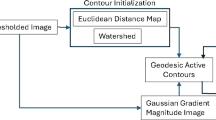Abstract
In the last few years, the advances in three-dimensional medical image processing have made possible operations like planning or simulation over real data. Different representations of structures or models have been proposed, being the implicit surfaces one of the most flexible models for processing. This paper introduces a new method for computing the implicit surfaces from the explicit representations of the objects segmented in three-dimensional images. This proposal is based on the approximation of the surfaces using distance functions and natural neighbor interpolation. The system has been tested over CT images of tibia and femur where the explicit representation has been extracted through a TAV model [1]. The results obtained show the suitability of the method for a correct representation of the target objects.
Preview
Unable to display preview. Download preview PDF.
Similar content being viewed by others
References
Barreira, N., Penedo, M.G.: Topological active volumes for segmentation and shape reconstruction of medical images. In: Campilho, A.C., Kamel, M.S. (eds.) ICIAR 2004. LNCS, vol. 3212, pp. 43–50. Springer, Heidelberg (2004)
Bloomenthal, J.: An implicit surface polygonizer. In: Graphics gems IV, pp. 324–349. Academic Press Professional, Inc., London (1994)
Boissonnat, J.D., Cazals, F.: Smooth Surface Reconstruction via Natural Neighbor Interpolation of Distance Functions. In: Proceedings of 16th Annual ACM Symposium on Computational Geometry, pp. 223–232 (2000)
Breen, D.E., Mauch, S., Whitaker, R.T., Mao, J.: 3D Metamorphosis between different types of geometric models. In: Eurographics 2001 Proceedings, September 2001, pp. 36–48. Blackwell Publishers, Malden (2001)
Duda, R.O., Hart, P.E.: Pattern classification and scene analysis. Wiley Interscience, Hoboken (1973)
Leboran, V., Dosil, R., Pardo, X.M.: Smooth Surface Reconstruction from Points and Normals using Implicit Surfaces. In: Actas del XIII Congreso Español de Informática Gráfica (CEIG 2003), pp. 203–216 (2003)
Osher, S., Fedkiw, R.: Level Set Methods and Dynamic Implicit Surfaces. Springer, Heidelberg (2003)
Chen, S., O’Brien, J.F., Shewchuk, J.R.: Interpolating and Approximating Implicit Surfaces from Polygon Soup. In: Proc. of ACM SIGGRAPH 2004 (2004)
Satherley, R., Jones, M.W.: Hybrid distance field computation for volumetric objects. In: Proceedings of the Joint IEEE TCVG and Eurographics Workshop, pp. 121–133 (2001)
Yngve, G., Turk, G.: Robust Creation of Implicit Surfaces from Polygonal Meshes. IEEE Transactions on Visualization and Computer Graphics 8(4), 346–359 (2002)
Author information
Authors and Affiliations
Editor information
Editors and Affiliations
Rights and permissions
Copyright information
© 2005 Springer-Verlag Berlin Heidelberg
About this paper
Cite this paper
Rouco, J., Barreira, N., Penedo, M.G., Pardo, X.M. (2005). Conversion into Three-Dimensional Implicit Surface Representation from Topological Active Volumes Based Segmentation. In: Marques, J.S., Pérez de la Blanca, N., Pina, P. (eds) Pattern Recognition and Image Analysis. IbPRIA 2005. Lecture Notes in Computer Science, vol 3522. Springer, Berlin, Heidelberg. https://doi.org/10.1007/11492429_8
Download citation
DOI: https://doi.org/10.1007/11492429_8
Publisher Name: Springer, Berlin, Heidelberg
Print ISBN: 978-3-540-26153-7
Online ISBN: 978-3-540-32237-5
eBook Packages: Computer ScienceComputer Science (R0)




